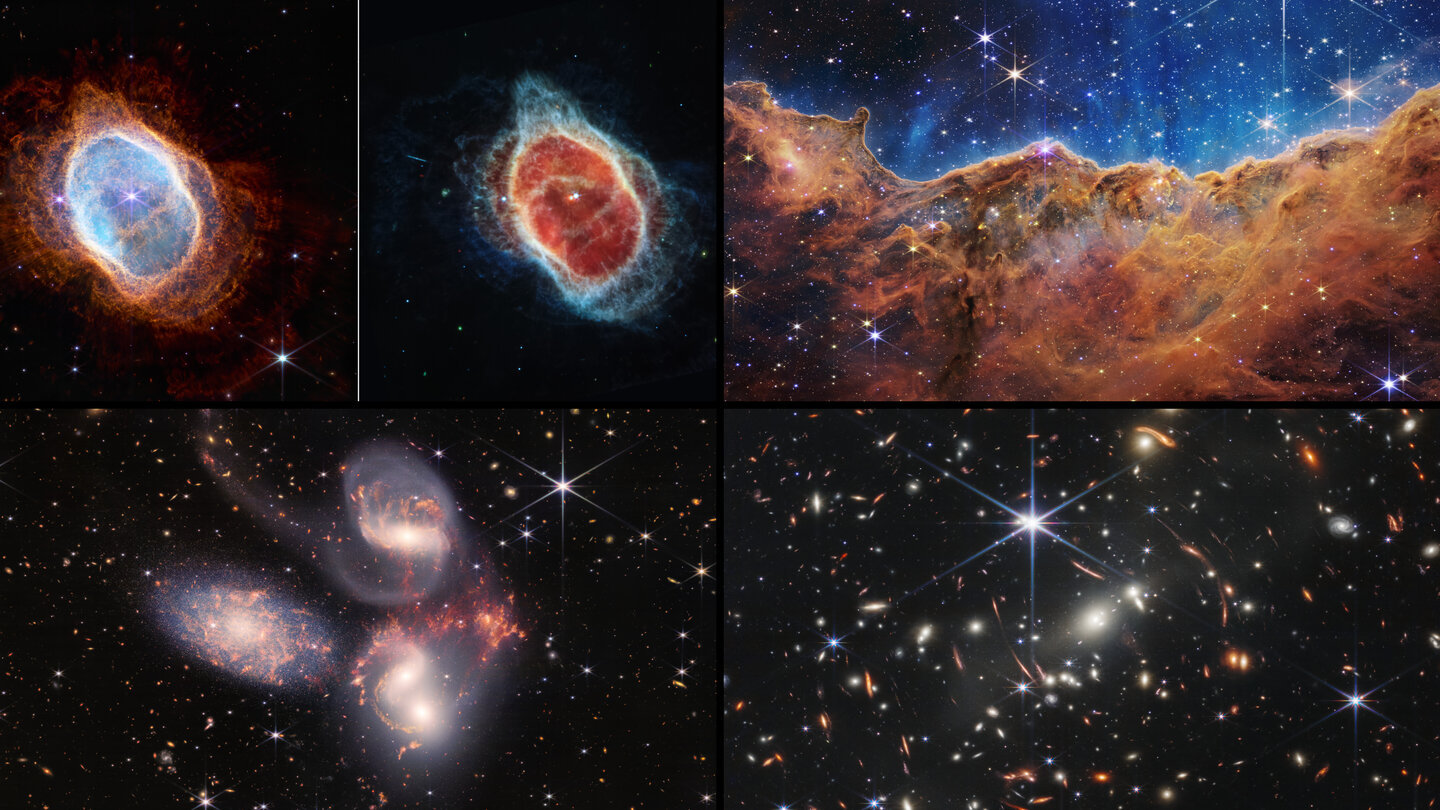This montage shows a few of the highlights: Top left: the Southern Ring planetary nebula in near- and mid-infrared, the product of a dying star. Read more about this object Top right: star formation in the Carina Nebula. Read more about this object Bottom left: Stephan’s Quintet, an interacting galaxy group. Read more about this object Bottom right: Webb’s first deep field. Read more about this object NASA, ESA, CSA, and STScI
Highly anticipated observations hint at treasure trove of discoveries to come
The dawn of a new era in astronomy has begun as the world gets its first look at the full capabilities of the NASA/ESA/CSA James Webb Space Telescope. The telescope’s first full-colour images and spectroscopic data, which uncover a spectacular collection of cosmic features that have remained elusive until now, were released today.
Webb’s first observations tell the story of the hidden Universe through every phase of cosmic history – from neighbouring exoplanets to the most distant observable galaxies in the early Universe, to everything in between.
“Today, we present humanity with a groundbreaking new view of the cosmos from the James Webb Space Telescope – a view the world has never seen before,” said NASA Administrator Bill Nelson. “These images, including the deepest infrared view of our Universe that has ever been taken, show us how Webb will help to uncover the answers to questions we don’t even yet know to ask; questions that will help us better understand our universe and humanity’s place within it.
“The Webb team’s incredible success is a reflection of what NASA does best. We take dreams and turn them into reality for the benefit of humanity. I can’t wait to see the discoveries that we uncover – the team is just getting started!”
“These first images and spectra from Webb are a huge celebration of the international collaboration that made this ambitious mission possible,” says Josef Aschbacher, ESA Director General. “I want to thank everyone involved with commissioning of this magnificent telescope and the delivery of these first incredible products from Webb for making this historic day a reality.”
Today’s images and spectra reveal the capabilities of all four of Webb’s state-of-the-art scientific instruments and confirm that the observations ahead will revolutionise our understanding of the cosmos and our own origins.
“This is the start of a new era viewing the Universe and making exciting scientific discoveries with Webb,” says Günther Hasinger, ESA’s Director of Science. “As we now begin regular science operations, I know the European astronomical community cannot wait to see the results of the observing time they have won for Webb’s first year.”
“Working on this mission has been one of the biggest highlights and most rewarding parts of my career,” says Macarena Garcia Marin, MIRI ESA Instrument Scientist. “My colleagues and I are eager to see what Webb can do and what surprises await us with its unprecedented combination of sharpness and sensitivity.”
Webb’s first observations were selected by a group of representatives from NASA, ESA, CSA, and the Space Telescope Science Institute:
The release of Webb’s first images and spectra kicks off the beginning of Webb’s science operations, where astronomers around the world will have their chance to observe anything from objects within our Solar System to the early Universe using Webb’s four instruments.
The James Webb Space Telescope launched on 25 December 2021, on an Ariane 5 rocket from Europe’s Spaceport in French Guiana, South America. After completing the most complex and difficult deployment sequence in space, Webb underwent months of commissioning where its mirrors were painstakingly aligned, and its instruments were calibrated to its space environment and prepared for science.
About Webb
The James Webb Space Telescope is the world’s premier space science observatory. Webb will solve mysteries in our solar system, look beyond to distant worlds around other stars, and probe the mysterious structures and origins of our universe and our place in it. Webb is an international program led by NASA with its partners, ESA and the Canadian Space Agency.The major contributions of ESA to the mission are: the NIRSpec instrument; the MIRI instrument optical bench assembly; the provision of the launch services; and personnel to support mission operations. In return for these contributions, European scientists will get a minimum share of 15% of the total observing time, like for the NASA/ESA Hubble Space Telescope.
